The document provides an overview of changes to CPT codes that will take effect in 2024, with a focus on changes relevant to clinical documentation. Key points include:
- There are 145 total codes added, 34 deleted, and 55 revised across various sections.
- Changes are provided for the Radiology, Laboratory/Pathology, and Category III sections. New codes are added for things like non-invasive coronary FFR estimation using AI and various intraoperative ultrasound exams.
- Guidelines are established for new genomic sequencing procedures codes focusing on solid organ and hematolymphoid neoplasms. Definitions are also provided for various genomic analysis techniques.
- Several Tier I and Tier II molecular
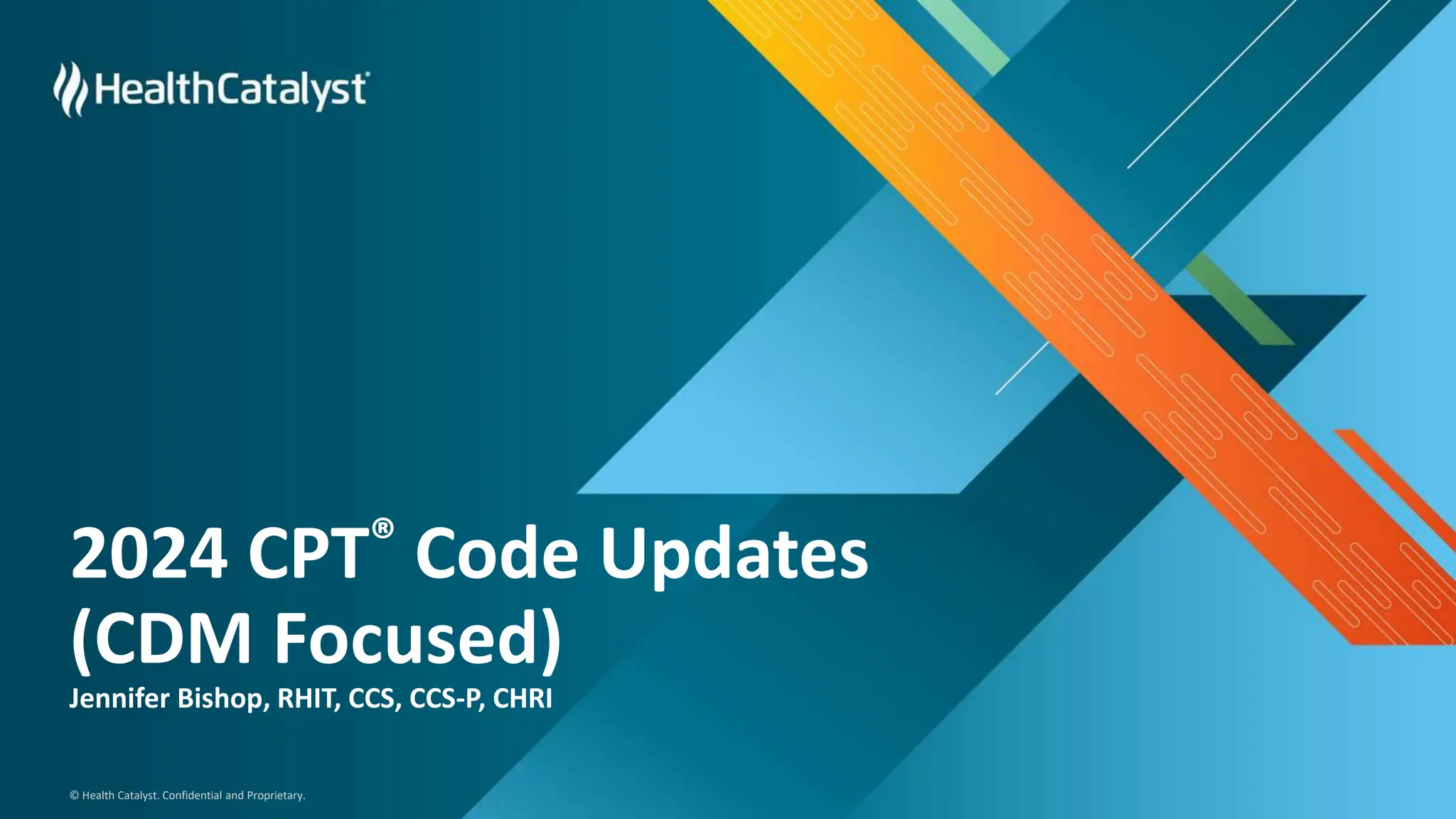
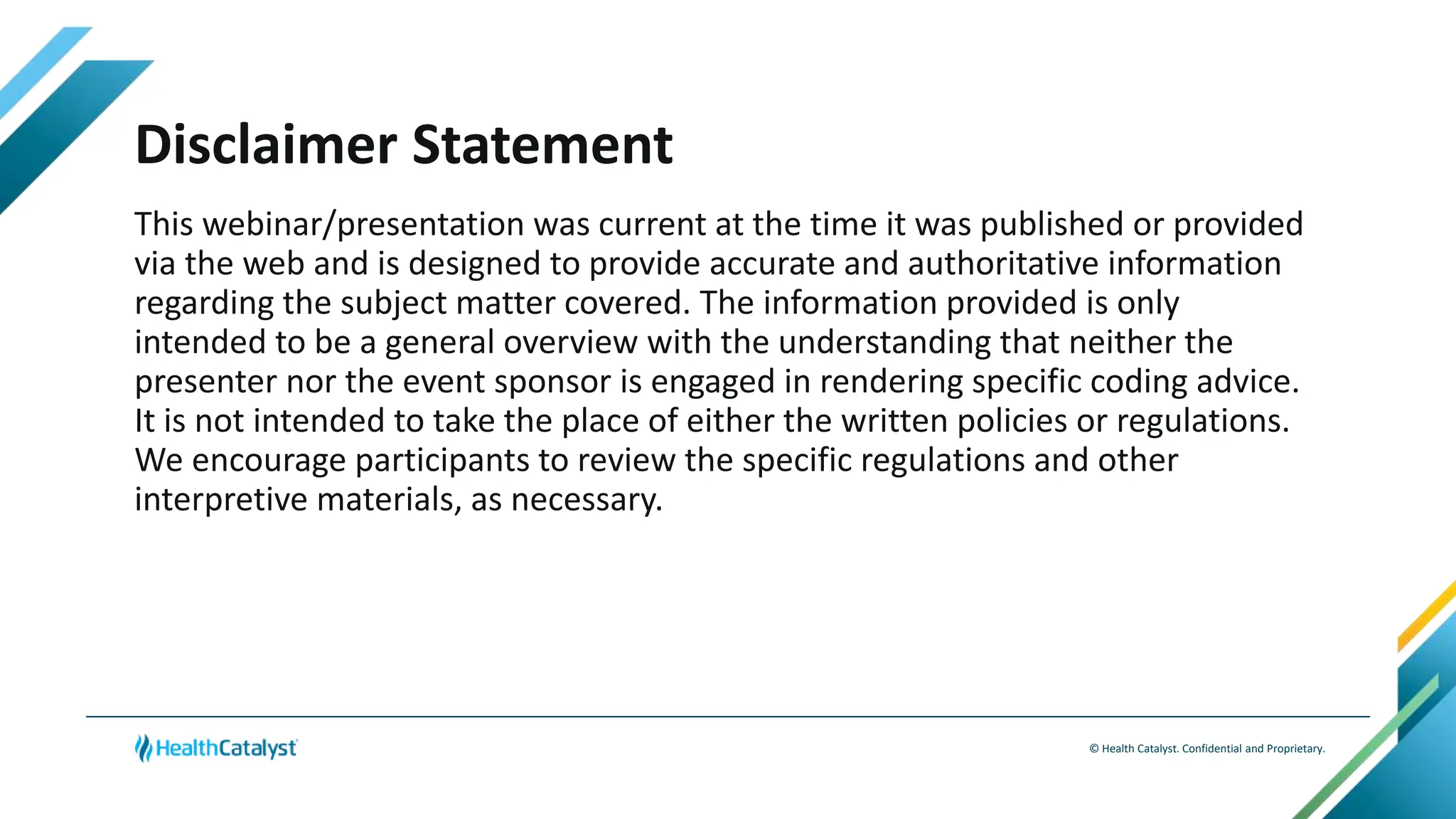
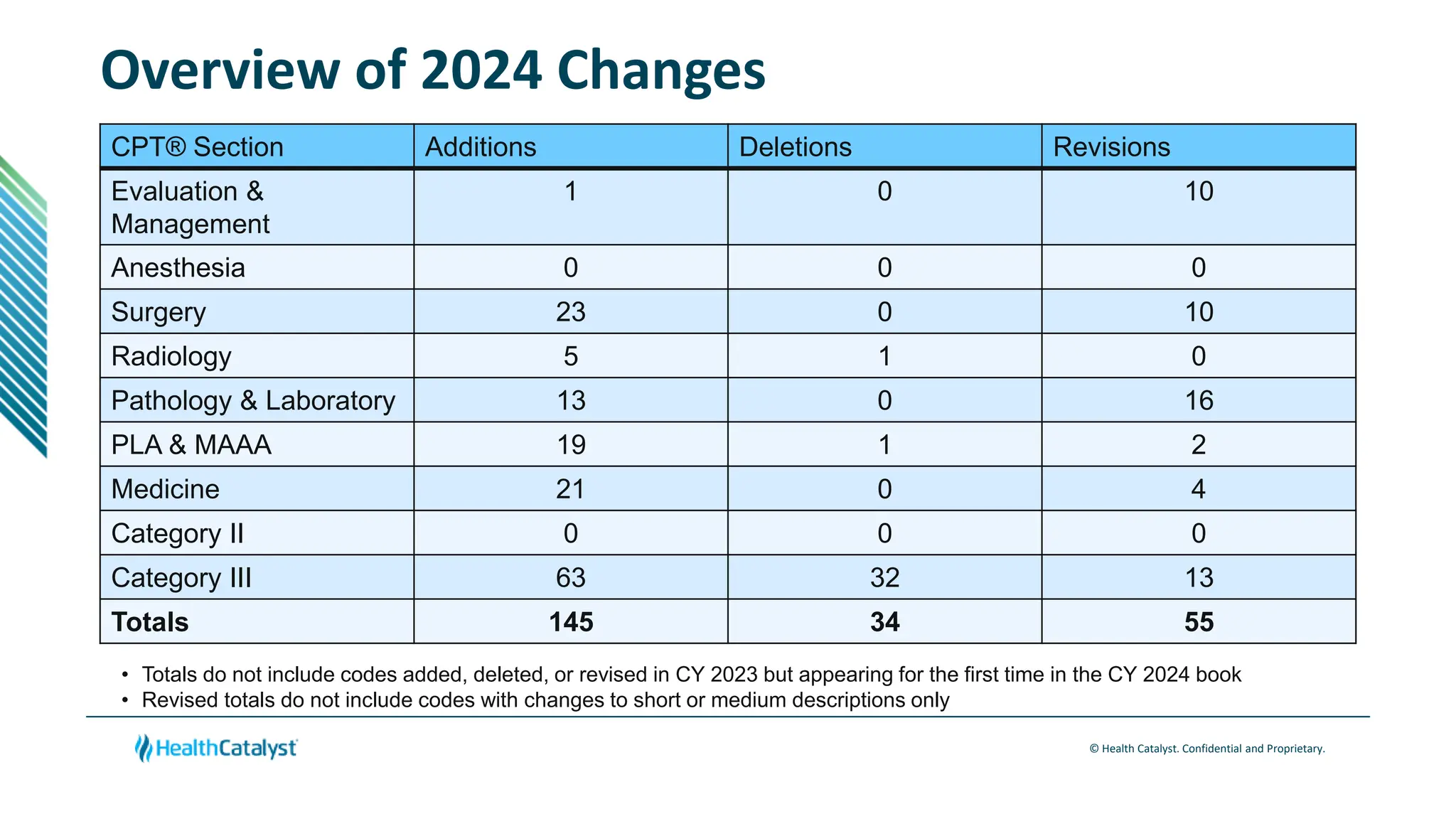






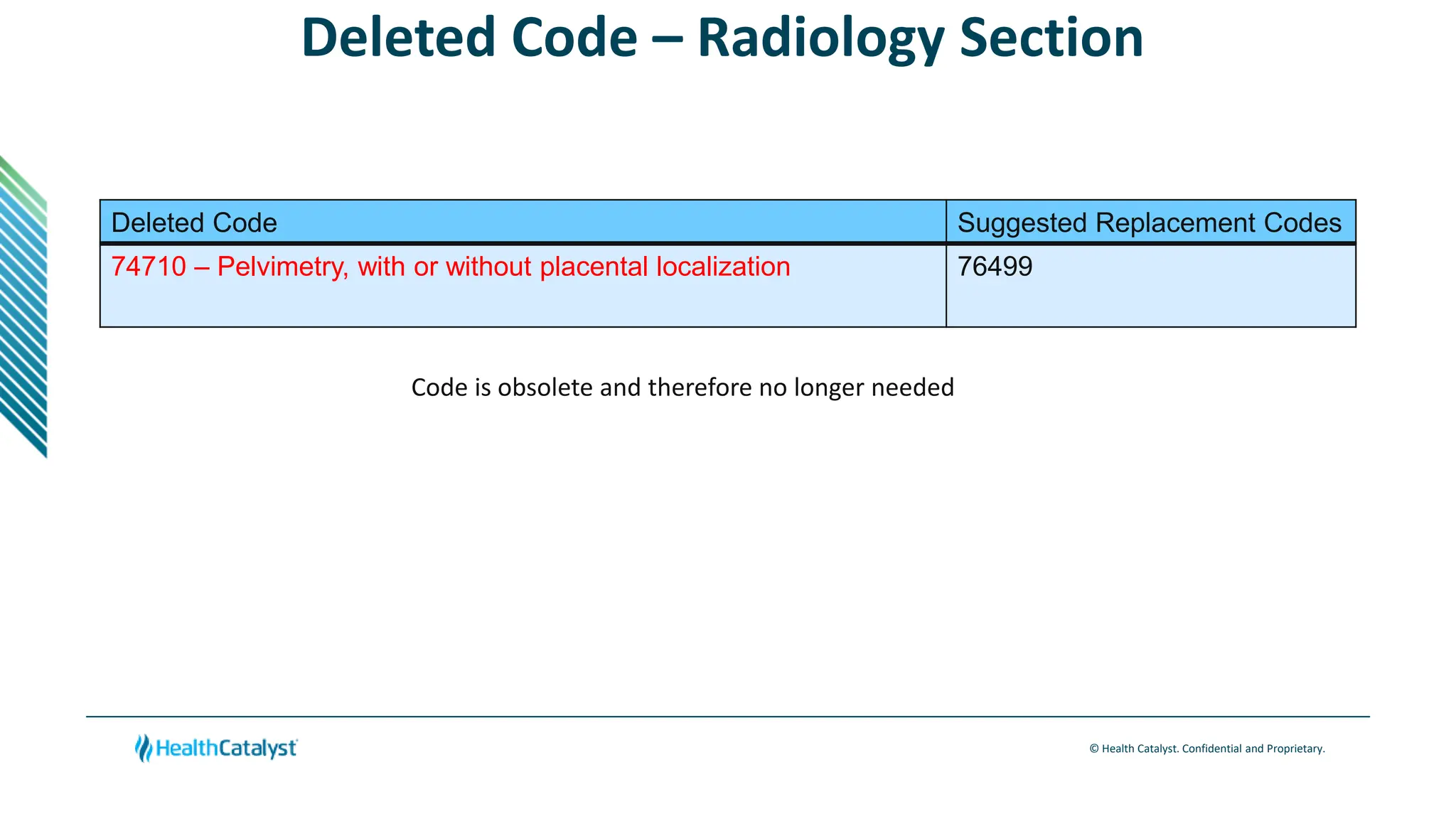







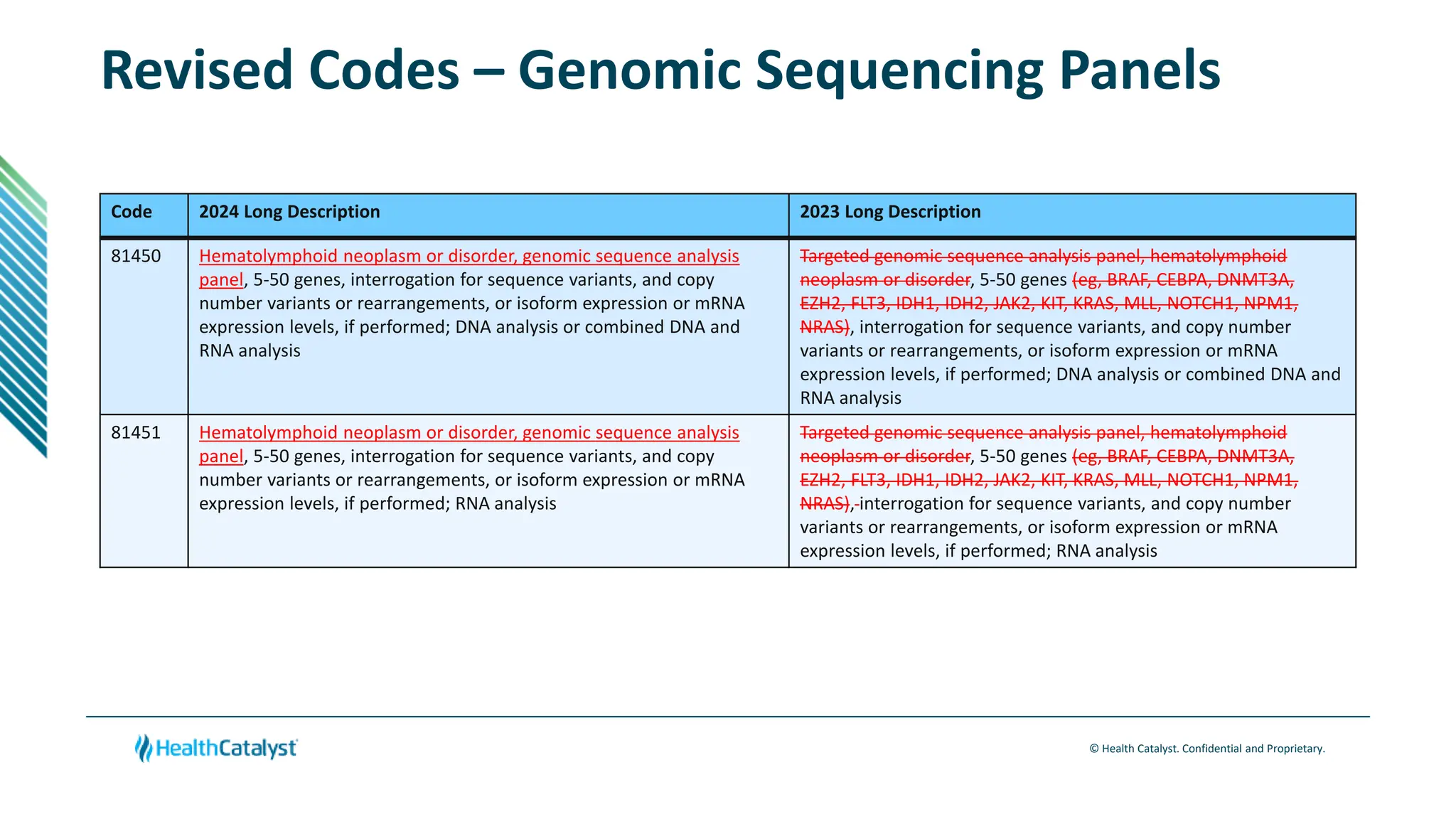

![© Health Catalyst. Confidential and Proprietary.
Revised Codes – Tier I Molecular Pathology
Code 2024 Long Description 2023 Long Description
81171 AFF2 (ALF transcription elongation factor 2 [FMR2]) (e.g., fragile X
intellectual disability 2 [FRAXE]) gene analysis; evaluation to detect
abnormal (e.g., expanded) alleles
AFF2 (AF4/FMR2 family, member 2 [FMR2]) (e.g., fragile X mental
retardation 2 [FRAXE]) gene analysis; evaluation to detect abnormal
(e.g., expanded) alleles
81172 AFF2 (ALF transcription elongation factor 2 [FMR2]) (e.g., fragile X
intellectual disability 2 [FRAXE]) gene analysis; characterization of
alleles (e.g., expanded size and methylation status)
AFF2 (AF4/FMR2 family, member 2 [FMR2]) (e.g., fragile X mental
retardation 2 [FRAXE]) gene analysis; characterization of alleles
(e.g., expanded size and methylation status)](https://image.slidesharecdn.com/2024cpt-hcpcsupdatescdm20231213final-231212201719-0a2077dc/75/2024-CPT-Code-Updates-CDM-Focused-Part-1-20-2048.jpg)
![© Health Catalyst. Confidential and Proprietary.
Revised Codes – Tier I Molecular Pathology
Code 2024 Long Description 2023 Long Description
81243 FMR1 (fragile X messenger ribonucleoprotein 1) (e.g., fragile X
syndrome, X-linked intellectual disability [XLID]) gene analysis;
evaluation to detect abnormal (e.g., expanded) alleles
FMR1 (fragile X mental retardation 1) (e.g., fragile X mental
retardation) gene analysis; evaluation to detect abnormal (e.g.,
expanded) alleles
81244 FMR1 (fragile X messenger ribonucleoprotein 1) (e.g., fragile X
syndrome, X-linked intellectual disability [XLID]) gene analysis;
characterization of alleles (e.g., expanded size and promoter
methylation status)
FMR1 (fragile X mental retardation 1) (e.g., fragile X mental
retardation) gene analysis; characterization of alleles (e.g.,
expanded size and promoter methylation status)](https://image.slidesharecdn.com/2024cpt-hcpcsupdatescdm20231213final-231212201719-0a2077dc/75/2024-CPT-Code-Updates-CDM-Focused-Part-1-21-2048.jpg)
![© Health Catalyst. Confidential and Proprietary.
Revised Codes – Tier II Molecular Pathology
CPT Codes 81403-81407 have been revised to replace “mental retardation” terminology
with “intellectual disability”
CPT codes 81405 and 81406 have revised “methyltransferase homolog 1 [E. coli]” to “2’-
O-methyltransferase 1”](https://image.slidesharecdn.com/2024cpt-hcpcsupdatescdm20231213final-231212201719-0a2077dc/75/2024-CPT-Code-Updates-CDM-Focused-Part-1-22-2048.jpg)


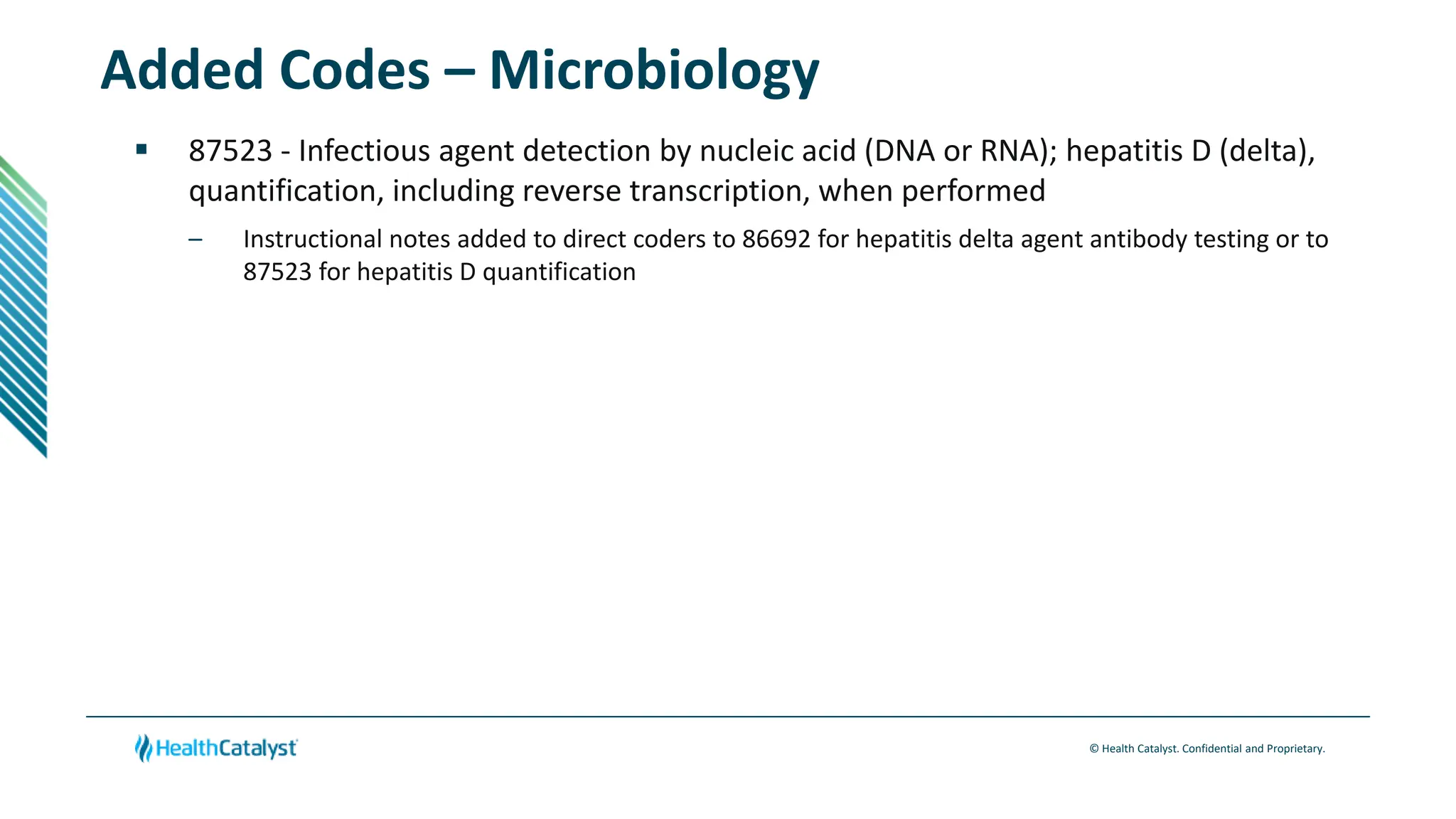
![© Health Catalyst. Confidential and Proprietary.
Added Code – Multianalyte Assays with Algorithmic Analyses
81517 - Liver disease, analysis of 3 biomarkers (hyaluronic acid [HA], procollagen III
amino terminal peptide [PIIINP], tissue inhibitor of metalloproteinase 1 [TIMP-1]),
using immunoassays, utilizing serum, prognostic algorithm reported as a risk score
and risk of liver fibrosis and liver-related clinical events within 5 years
– Same descriptor as 0014M, which has been deleted
– Enhanced Liver Fibrosis™ Test found to have clinical utility and therefore moved to a Category I
code](https://image.slidesharecdn.com/2024cpt-hcpcsupdatescdm20231213final-231212201719-0a2077dc/75/2024-CPT-Code-Updates-CDM-Focused-Part-1-26-2048.jpg)
![© Health Catalyst. Confidential and Proprietary.
Deleted Code – Multianalyte Assays with Algorithmic Analyses
Deleted Code Suggested Replacement Codes
0014M – Liver disease, analysis of 3 biomarkers (hyaluronic acid
[HA], procollagen III amino terminal peptide [PIIINP], tissue inhibitor
of metalloproteinase 1 [TIMP-1]), using immunoassays, utilizing
serum, prognostic algorithm reported as a risk score and risk of liver
fibrosis and liver-related clinical events within 5 years
81517](https://image.slidesharecdn.com/2024cpt-hcpcsupdatescdm20231213final-231212201719-0a2077dc/75/2024-CPT-Code-Updates-CDM-Focused-Part-1-27-2048.jpg)





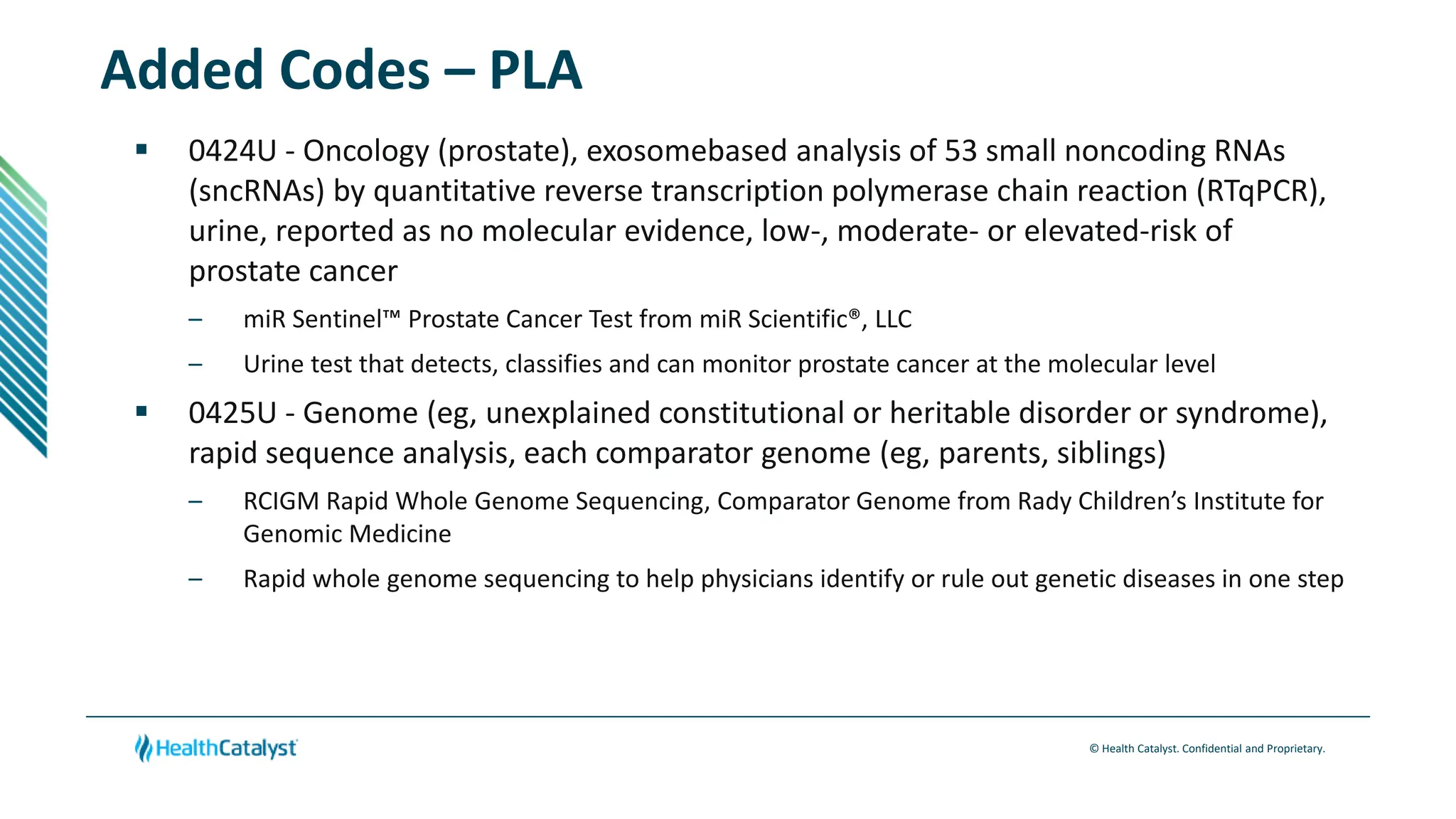


![© Health Catalyst. Confidential and Proprietary.
Added Codes – PLA
0430U - Gastroenterology, malabsorption evaluation of alpha-1-antitrypsin,
calprotectin, pancreatic elastase and reducing substances, feces, quantitative
– Malabsorption Evaluation Panel from Mayo Clinic
– Provides differentiation between causes of malabsorption, specifically inflammatory conditions,
pancreatic insufficiency, and osmotic diarrhea
0431U - Glycine receptor alpha1 IgG, serum or cerebrospinal fluid (CSF), live cell-
binding assay (LCBA), qualitative
– Glycine Receptor Alpha1 IgG from Mayo Clinic
– Evaluates patients with suspected autoimmune stiff-person spectrum disorders (stiff-person
syndrome, stiff-limb, stiff trunk or progressive encephalomyelitis with rigidity and myoclonus
[PERM]) using serum specimens](https://image.slidesharecdn.com/2024cpt-hcpcsupdatescdm20231213final-231212201719-0a2077dc/75/2024-CPT-Code-Updates-CDM-Focused-Part-1-36-2048.jpg)









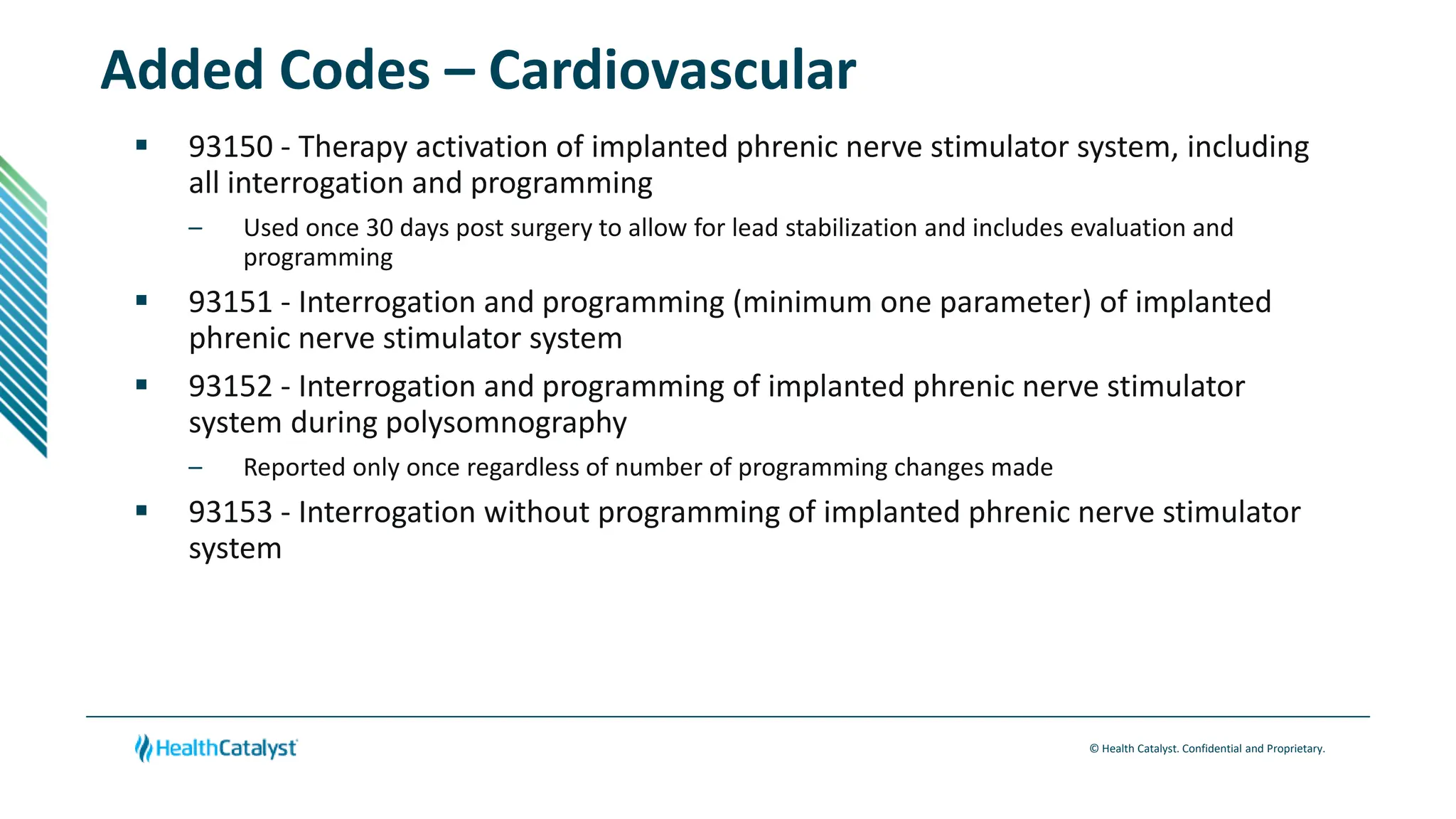
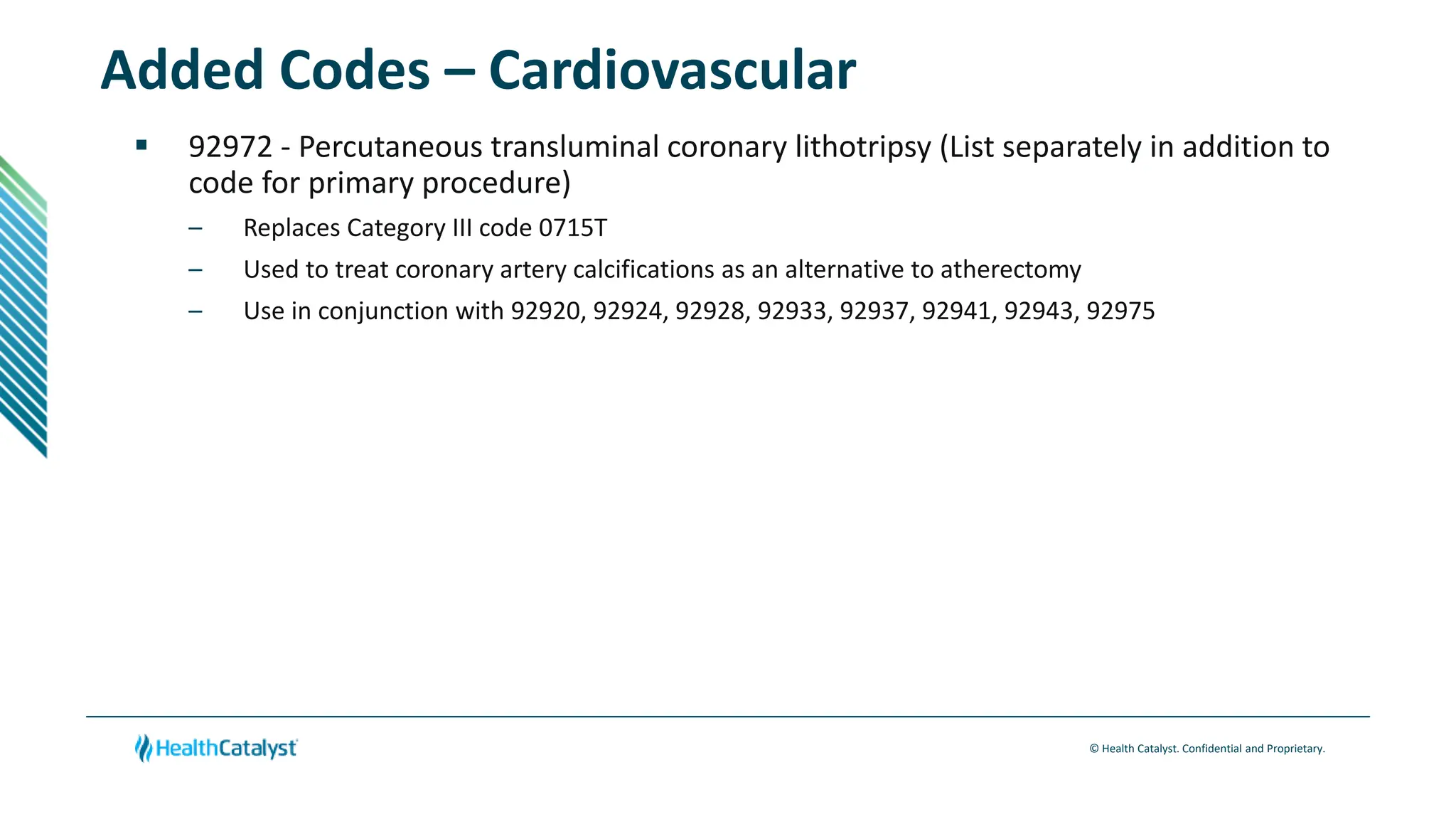




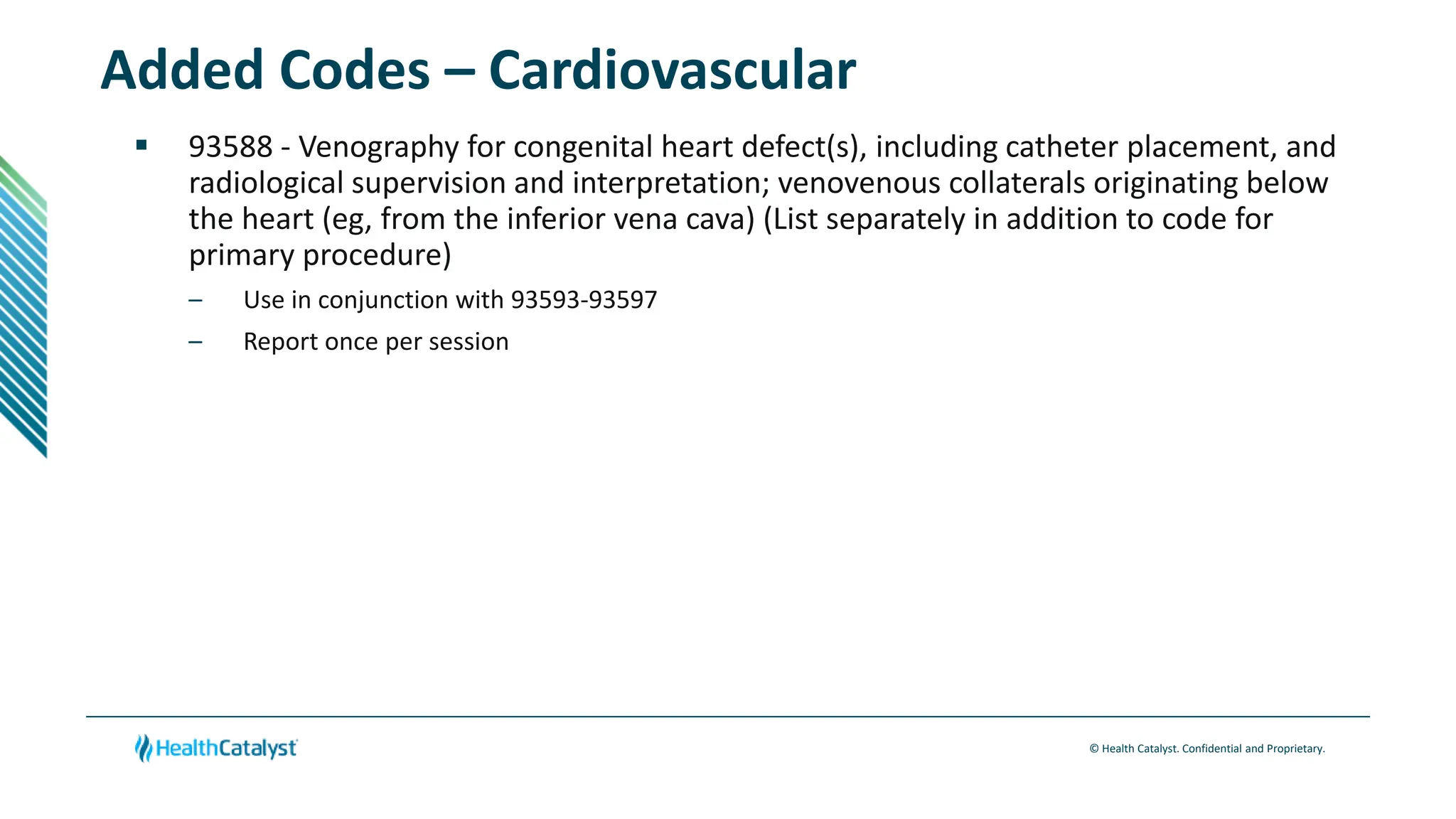






![© Health Catalyst. Confidential and Proprietary.
Added Codes – Physical Medicine
97550 - Caregiver training in strategies and techniques to facilitate the patient’s
functional performance in the home or community (eg, activities of daily living
[ADLs], instrumental ADLs [iADLs], transfers, mobility, communication, swallowing,
feeding, problem solving, safety practices) (without the patient present), face to face;
initial 30 minutes
97551 - Caregiver training in strategies and techniques to facilitate the patient’s
functional performance in the home or community (eg, activities of daily living
[ADLs], instrumental ADLs [iADLs], transfers, mobility, communication, swallowing,
feeding, problem solving, safety practices) (without the patient present), face to face;
each additional 15 minutes (List separately in addition to code for primary service)
97552 - Group caregiver training in strategies and techniques to facilitate the
patient's functional performance in the home or community (eg, activities of daily
living [ADLs], instrumental ADLs [iADLs], transfers, mobility, communication,
swallowing, feeding, problem solving, safety practices) (without the patient present),
face to face with multiple sets of caregivers](https://image.slidesharecdn.com/2024cpt-hcpcsupdatescdm20231213final-231212201719-0a2077dc/75/2024-CPT-Code-Updates-CDM-Focused-Part-1-59-2048.jpg)

















![© Health Catalyst. Confidential and Proprietary.
Deleted Codes - New & Emerging Technology
Deleted Code Suggested Replacement Codes
0641T - Noncontact near-infrared spectroscopy studies of flap or
wound (eg, for measurement of deoxyhemoglobin, oxyhemoglobin,
and ratio of tissue oxygenation [StO2]); image acquisition only, each
flap or wound
0859T
0860T
0642T - Noncontact near-infrared spectroscopy studies of flap or
wound (eg, for measurement of deoxyhemoglobin, oxyhemoglobin,
and ratio of tissue oxygenation [StO2]); interpretation and report
only, each flap or wound
0859T
0860T](https://image.slidesharecdn.com/2024cpt-hcpcsupdatescdm20231213final-231212201719-0a2077dc/75/2024-CPT-Code-Updates-CDM-Focused-Part-1-77-2048.jpg)
![© Health Catalyst. Confidential and Proprietary.
Revised Codes – New & Emerging Technology
Code 2024 Long Description 2023 Long Description
0640T Noncontact near-infrared spectroscopy (e.g., for
measurement of deoxyhemoglobin,
oxyhemoglobin, and ratio of tissue oxygenation),
other than for screening for peripheral arterial
disease, image acquisition, interpretation, and
report; first anatomic site
Noncontact near-infrared spectroscopy studies
of flap or wound (e.g., for measurement of
deoxyhemoglobin, oxyhemoglobin, and ratio of
tissue oxygenation [StO2]); image acquisition,
interpretation and report, each flap or wound](https://image.slidesharecdn.com/2024cpt-hcpcsupdatescdm20231213final-231212201719-0a2077dc/75/2024-CPT-Code-Updates-CDM-Focused-Part-1-78-2048.jpg)




